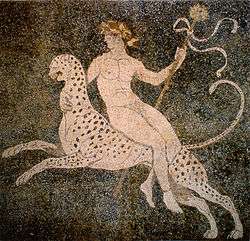Archaeological Museum of Pella
The Archaeological Museum of Pella (Greek: Αρχαιολογικό Μουσείο Πέλλας) is a museum in Pella in the Pella regional unit of Central Macedonia. The building was designed by architect Kostas Skroumpellos and is on the site of the ancient city of Pella. It was completed in 2009 with the support of the Greece's Third Community Support Framework.
Αρχαιολογικό Μουσείο Πέλλας | |
 An exterior view | |

| |
| Established | 2009 |
|---|---|
| Location | Pella 580 05, Pella, Central Macedonia, Greece |
| Coordinates | 40°45′43″N 22°31′09″E |
| Type | Archaeological |
| Website | www.pella-museum.gr |
It is situated near the archaeological site of the ancient Macedonian palace. The building has a rectangular atrium, as a reference to the central peristyle courtyard of ancient houses in Pella.
The information section provides texts, photographs, maps, drawings a model of the archaeological site and a short video about Pella. In the entrance there are two important exhibits: A head considered a portrait of Alexander the Great and a statuette with the characteristic attributes of the god Pan.
The daily life of Pella is the first thematic group of the exhibition. The most important exhibits are the mosaic floors from the Houses of Dionysus, and of the Abduction of Helen from the House of the Wall Plasters. The excavation finds provide much information about daily life in ancient Pella (restoration of furniture and models, cloths, etc.)
The second thematic group is about public life in Pella. The finds come from excavations in the Agora and are related to the city's administration (coins, inscriptions, sculpture), the production and commerce (vases for transporting wines terracotta figurines, equipment from pottery).
The third thematic group consists of mosaics from Pella’s sanctuaries (the sanctuaries of Darron, the Mother of Gods and Aphrodite, the Thesmophorion), and other findings as inscriptions, vases, metal objects.
The fourth thematic group is the findings from the city’s cemeteries. There are burials from the Bronze Age, the Iron Age, Geometric and Archaic periods (9th-6th BC centuries), the Classical era (5th-4th BC centuries), and the Hellenistic period (3rd, 2nd BC centuries). The findings give information about the language of the residents (Doric Greek language), the funeral customs etc.
The last grouping is the palace gallery and presents information about the architectural form of the palace, and the life and personality of Alexander the Great.
Gallery
 The Stag Hunt Mosaic
The Stag Hunt Mosaic
(c. 300 BC) Marble head of Alexander the Great (325-300 BC). Chance find from the area of Giannitsa.
Marble head of Alexander the Great (325-300 BC). Chance find from the area of Giannitsa. Small food bowls from a cupboard in an ancient house (late 4th-early 1st BC century)
Small food bowls from a cupboard in an ancient house (late 4th-early 1st BC century)- Terracotta figurine of Aphrodite removing her sandal. Votive offerings from the Sanctuary of the Mother of Gods and Aphrodite (late 4th-early 1st BC century)
 Cremation mid 5th century. Storage vessel used as an um. Female terracotta figurine
Cremation mid 5th century. Storage vessel used as an um. Female terracotta figurine Elements of decoration of wooden burial couches and coffers
Elements of decoration of wooden burial couches and coffers Mould of a Satyr and figure from the mould in the form of an incense burner
Mould of a Satyr and figure from the mould in the form of an incense burner Rhyton in the form of phallus (drinking and libation vessel)
Rhyton in the form of phallus (drinking and libation vessel).jpg) Bronze helmet
Bronze helmet Arms
Arms Detail from a mosaic 'Griffin attacking deer'
Detail from a mosaic 'Griffin attacking deer' 'Hunting a lion' mosaic
'Hunting a lion' mosaic Detail from the mosaic
Detail from the mosaic Decoration of the dining room wall in a house known as the house of the plasterworks
Decoration of the dining room wall in a house known as the house of the plasterworks Dionysos mosaic
Dionysos mosaic Exhibits
Exhibits.jpg) Exhibits
Exhibits Poseidon bronze statuette
Poseidon bronze statuette
Sources
- This article incorporates text from the corresponding article at the Museums of Macedonia website, commissioned by the Macedonian Heritage foundation, written by Vlasis Vlasidis, and published under a CC-BY-SA-3.0 license.